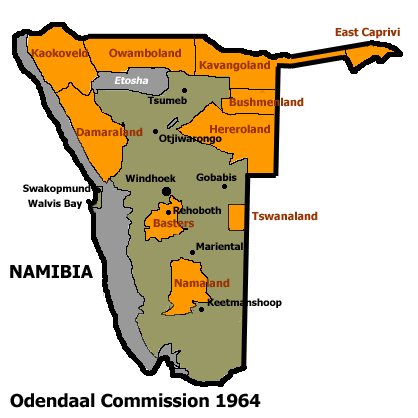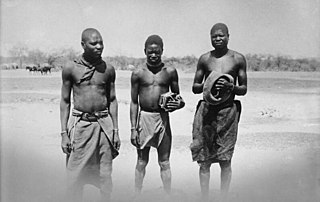
The Ovambo people, also called Aawambo, Ambo, Aawambo, or Ovawambo (Kwanyama), are a Bantu ethnic group native to Southern Africa, primarily modern Namibia. They are the single largest ethnic group in Namibia, accounting for about half of the population. Despite concerted efforts from Christian missionaries to wipe out what were believed to be 'pagan practices', they have retained many aspects of their cultural practices. They are also found in the southern Angolan province of Cunene, where they are more commonly referred to as "Ambo". The Ovambo consist of a number of kindred Bantu ethnic tribes who inhabit what was formerly called Ovamboland. In Angola, they are a minority, accounting for about two percent of the total Angolan population.
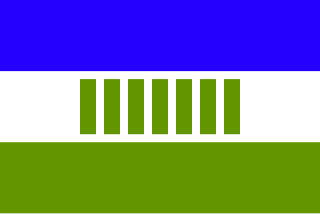
Ovamboland, also referred to as Owamboland, was a Bantustan and later a non-geographic ethnic-based second-tier authority, the Representative Authority of the Ovambos, in South West Africa.
Kwanyama or Cuanhama is a national language of Angola and Namibia. It is a standardized dialect of the Ovambo language, and is mutually intelligible with Oshindonga, the other Ovambo dialect with a standard written form.

Herman Andimba Toivo ya Toivo was a Namibian anti-apartheid activist, politician and political prisoner. Ya Toivo was active in the pre-independence movement, and is one of the co-founders of the South West African People's Organisation (SWAPO) in 1960, and before that, its predecessor the Ovamboland People's Organization (OPO) in 1959.
Colin O'Brien Winter, was an English Anglican bishop, who served as Bishop of Damaraland, a diocese of the Church of the Province of Southern Africa coextensive with the territory of what is now Namibia during the apartheid era.
Peter Tanyangenge Kalangula was a Namibian political and religious leader. Bishop Kalangula had an interesting personal history that involved both politics and church.
Nelson Wellesley Fogarty (1871–1933) was the first Anglican Bishop of Damaraland (Namibia) from 1924 to 1933.
James Hamupanda Kauluma was a Namibian human rights activist and sixth bishop of the Anglican Diocese of Namibia. He was the first Namibian bishop of the Anglican diocese in the country.
Edward Sydney Morrow (1934–2003) Anglican priest and anti-apartheid activist in Namibia, England, Swaziland, Zimbabwe and South Africa.

Carl Hugo Hahn (1818–1895) was a Baltic German missionary and linguist who worked in South Africa and South-West Africa for most of his life. Together with Franz Heinrich Kleinschmidt, he set up the first Rhenish mission station to the Herero people in Gross Barmen. Hahn is known for his scientific work on the Herero language.

The Ovambo language is a dialect cluster spoken by the Ovambo people in southern Angola and northern Namibia, of which the written standards are Kwanyama and Ndonga.

Religion in Namibia is dominated by various branches of Christianity, with more than 90 percent of Namibian citizens identifying themselves as Christian. According to the government's survey, in 2013 up to two-thirds of the country was Protestant, including as much as 44% Lutheran.
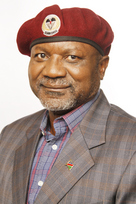
Major General Charles Dickson Ndaxu Phillip Namoloh is a Namibian diplomat, politician and military figure who served in the cabinet of Namibia as Minister of Safety and Security from March 2015 to March 2020. Namoloh has been a member of the National Assembly of Namibia since 2005; having served as Minister of Defence from 2005 to 2012 and Minister of Regional and Local Government, Housing and Rural Development from 2012 to 2015.

Mandume ya Ndemufayo was the last king of the Oukwanyama, a subset of the Ovambo people of southern Angola and northern Namibia. Ya Ndemufayo took over the kingdom in 1911 and his reign lasted until 1917 when he died of either suicide or machine gun fire while he was under attack from South African colonizers. Ya Ndemufayo is honoured as a national hero in both Angola and Namibia.
George Wolfe Robert Tobias (1882-1974) was the third Anglican Bishop of Damaraland (Namibia) from 1939 to 1949.

The Finnish Evangelical Lutheran Mission is a Lutheran missionary society formed on January 19, 1859, in Helsinki, Finland. It is one of seven organisations of the Evangelical Lutheran Church of Finland (ELCF) that conduct missionary work. Its first deployments outside Finland were made to Ovamboland, an area that today is cut by the Angola-Namibian border.
Odibo is a village in the north of Namibia close to the Angolan border known for its Anglican mission St Mary. It belongs to the Oshikango electoral constituency in the Ohangwena Region. Odibo is also an Archdeaconry in the Diocese of Namibia.
Leevi Gerson Max was an Ovambo pastor in the service of the Evangelical Lutheran Church in Namibia. He was one of the founders of the labour movement in Namibia.
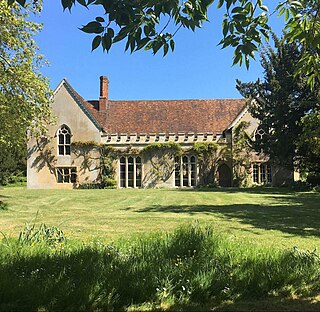
The Namibia International Peace Centre was a non-governmental organization which was active between 1974 and 1981. It was based in The Abbey, Sutton Courtenay and later in Bethnal Green, East London. It was established by Bishop Colin Winter (1928–1981), an English Anglican bishop, who served as Bishop of Damaraland, a diocese of the Church of the Province of Southern Africa coextensive with the territory of what is now Namibia during the apartheid era. The Namibia International Peace Centre supported SWAPO.

